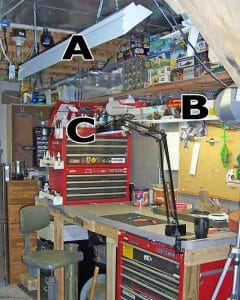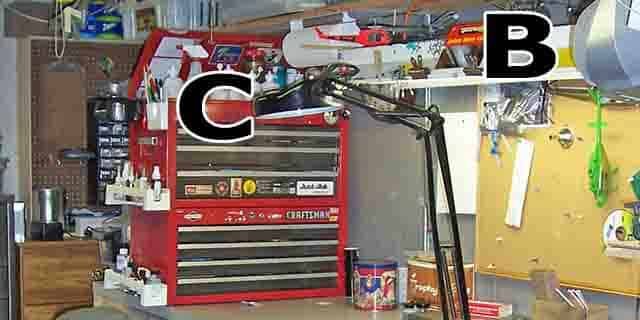Imagine drawing on the wall of a cave or trying to paint the ceiling of a 16th Century Chapel using nothing but a couple of candles to illuminate what you’re working on. Today’s hobbyist, craftsmen and artists don’t have to rely on the light emitted by a few candles. We can have ample lighting to see what we are doing with just the flip of a switch. This is accomplished through the use of overhead lights, task lights, and key lights. As an added bonus, in the 21st century we have access to full spectrum lighting and magnification lamps!
One of the last things we need when working on a project is to add undue stress to our eyes. For this reason, lighting is one of the key elements I look to improve upon with each rendition of my scale modeling cave, garage workshop or my wife’s craft room. Proper lighting makes any project easier to accomplish by reducing eye strain.
 Let’s think about lighting as a kitchen designer would. After all, a functional kitchen is a workshop too. The perfect lighting will start with good overhead lights to provide broad illumination of the entire room. Then to properly light up the work surface, in this case the countertop, the installation of task lights under the overhead cabinets is often necessary to illuminate the counter so you can see what you’re doing without shadows. Lastly, if you need pinpoint illumination to really illuminate what you are working on, you’ll want to add a key light. This key light can be a tabletop light, floor lamp or spotlight mounted above your workspace.
Let’s think about lighting as a kitchen designer would. After all, a functional kitchen is a workshop too. The perfect lighting will start with good overhead lights to provide broad illumination of the entire room. Then to properly light up the work surface, in this case the countertop, the installation of task lights under the overhead cabinets is often necessary to illuminate the counter so you can see what you’re doing without shadows. Lastly, if you need pinpoint illumination to really illuminate what you are working on, you’ll want to add a key light. This key light can be a tabletop light, floor lamp or spotlight mounted above your workspace.
When considering proper lighting, the type of bulb you choose will make a dramatic difference in your artistic endeavors. If you are drawing, painting or otherwise working with colored materials, it’s important to have color correct lighting. Not all light bulbs produce the same spectrum of light; some bulbs give objects a yellow tint, while others more of a blue. Always keep in mind that you need full spectrum lighting in order to adequately match colors when working with paints, fibers or beads.
If you are subject to eye strain or are working with very small objects, go ahead and bring in some magnification. Consider using a magnification lamp if you don’t want to light up the whole room or you just like sitting in your favorite chair. A Magnification lamp has a built in magnifying lens that not only lights up your work, but it also enlarges it so you can see the smallest objects clearly.
When it comes to lighting in your workplace, remember this:
- Overhead lights illuminate the entire area.
- Task lights illuminate the work surface.
- Key lights illuminate a specific area or object.
- Full spectrum lights allow proper color choice.
- Magnification lights enlarge small objects.
We’ve field tested several products in our quest for find the best lighting for hobbyists. Our personal favorite is the Carson MagniFlex Pro™– CP-90. It’s the one we rely on at hobby events because it can be used as a tabletop magnification lamp or can be clamped to another surface; it runs on battery or can be plugged in; and it’s infinitely maneuverable, all of which make it both versatile and easy to use.
Another trusted brand of lighting for hobbyists, crafters, and jewelers is from the Daylight Company. Their full-spectrum lighting reduces eye strain and provides superior color matching. My wife prefers this lamp for her cross stitching projects.
What do you use to light up your hobby or craft workspace?


Thanks for the information. I am adding the Carson MagiFlex to my wish list. Portability, what a concept! I may finally be able to work on my art away from the drawing tables.